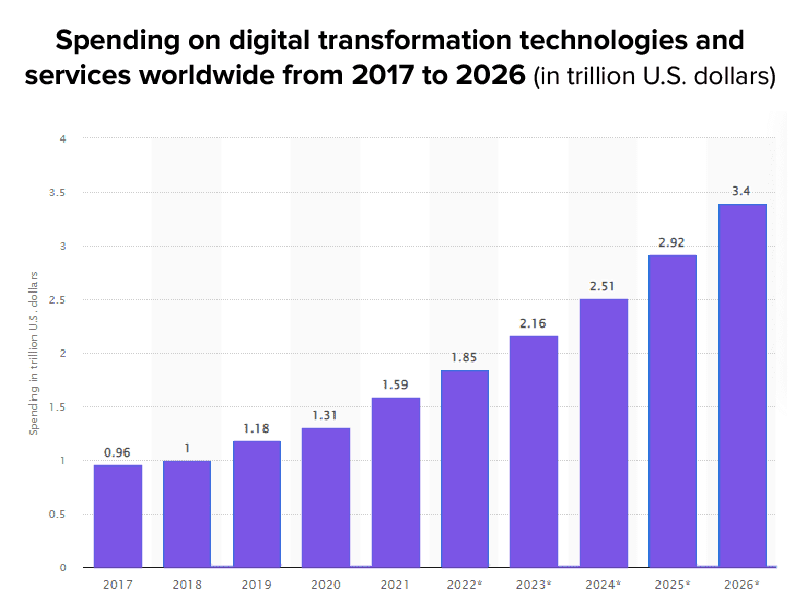
Digital transformation is the process through which companies get their businesses embedded with advanced technologies for driving fundamental change. The benefits? Greater agility, increased efficiency, and unlocking new opportunities and values for employees shareholders, and customers.
Global spending on digital transformation is expected to reach a valuation of 1.6 million by the end of the year 2022. By 2026, it will touch the value of 3.4 trillion U.S. dollars. This shows software development has become the need of the hour for thriving in the current business environment. Leveraging advanced technologies for creating high-end custom software solutions, businesses are now achieving their desired outcomes that are helping them to save time and improvise revenue while increasing efficiency.
If you’ve yet to automate your business, then give it the power of automation by hiring the best software development company where the experts can develop bespoke software solutions for you.
Changes Brought by Digital Transformation in the Software Development Industry
With the growing demand for custom software solutions from organizations of all sizes, the software digital transformation industry is gradually evolving. Here are some of the changes that digitalization brought to the software development industry:
1. Low-Code Development
Organizations have now adopted the low-code development approach that helps them to develop customized applications through pre-arranged blocks, thus eliminating the requirement for hand coding. This helps businesses to get their software development process accelerated and develop new apps in the least possible turnaround time.
The low-code development is one of the best strategies for small organizations and startups who are new to the digital transformation journey for developing custom software and applications. This also helps in lowering the cost of development and ensures minimal time for project completion.
2. Mobile-First Approach
90% of global internet users utilize a smartphone or mobile device. Not only this but it was also estimated that nearly 57% of global internet traffic was generated from smartphones as compared to 43% of traffic generated from laptops or desktops in the year 2022. Considering the significant popularity of mobile web browsing, businesses are now considering and privatizing the mobile-first approach.
The mobile-first approach means building mobile-based applications in software and then scaling those for desktop devices. This strategy allows the companies for expanding their customer base, thus boosting their brand loyalty through a great digital experience.
3. Better Integration
More and more companies are now increasingly scaling their businesses by shifting to mobile and cloud technologies. Software that is custom-built can get seamlessly integrated with the mobile and cloud performs with minimal downtime.
Proper integration during the software development lifecycle stage, can help businesses to gain a much-needed competitive advantage to the business.
4. Identifies Risk and Improvement Areas
Digital transformation comes with a host of benefits but it also has the potential of driving risks. These risks are likely associated with bugs and errors that can cause operational disruptions. Such disruptions affect tech companies leading to greater cost generation and unfulfilled tasks.
An efficient way of identifying such inefficiencies and other improvement areas is by deeply analyzing the code repositories. Few platforms can offer you the visibility of Git providers while utilizing a pattern-matching engine.
5. Agile Data-Driven Management
Agile data-driven management fosters business intelligence and flexibility. For attaining this, tech leaders focus on automated performance, reporting, and managing the entire team activity.
In this context, tools that offer access to the core engineering metrics can help tech leaders in achieving great results that transform business operations. Another key element is visibility over works that can access and improvise your team’s performance level.
6. API-First Approach
Application Programming Interface (API) allows multiple applications to communicate seamlessly with each other. With an API-first approach, the custom software developers create apps for interacting with other software and applications easily.
For instance, when the user clicks on the “connect with Facebook” button in the Candy Crush game the application does not ask for the user’s Facebook account details. Rather, it just requests access to data from the Facebook server for the user’s hassle-free login. This is how an API-first approach functions.
7. Increased Productivity and Efficiency
Digital technology increases productivity and efficiency by speeding up business processes in streamlining operations. For instance, robotic process automation (RPA) can easily outperform humans in many ways. Research says that bots can complete tasks almost 20 times faster than human beings.
Moreover, business intelligence and data analytic tools can analyze and collect data at an accuracy and speed that is unmatched by humans. Workers can utilize this analysis for making well-informed decisions faster than they could do without such advanced technologies.
Drive Change in your Business With Digital Transformation
While the advanced tools offer a seamless way of collaboration, they also help in moving the entire organization digitally ahead. This digital cultural shift is important for businesses for maintaining sustainability. It fosters digital learning and upskilling of the team members for taking the advantage of the perks of digital transformation.
Every organization and enterprise making strategic decisions must leverage digital transformation in business. Connect with a top-notch software development company for creating your own digital product that can help you earn a good ROI.
